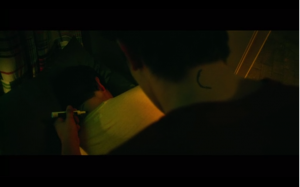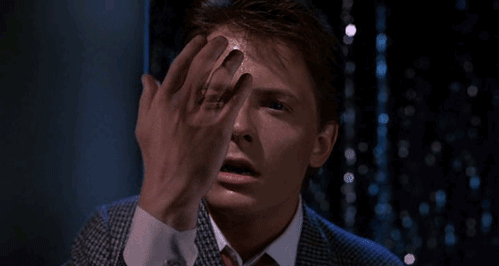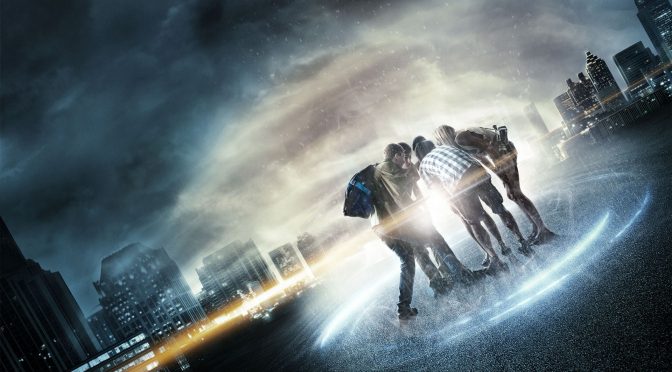This was a rough week. Waking up and getting ready to get ahead of my schedule Tuesday, I discovered that there were computer problems which had corrupted my operating system. The next few days had me making multiple mistakes and hitting several snags that I would kick myself over repeatedly. When all was said and done, I had the computer back, but my hard drive had to be erased and my most recent backup was sorely out of date due to another mistake I had made.
These are the times when a man needs a time machine.
But this week I also had a chance to watch Project Almanac, a film that I had heard of once before but had not actually taken the time to see. Not being a huge fan of found footage and wary of most time travel movies (more on that later), I wasn’t in a huge rush. But, frankly, there wasn’t a whole lot to do at that particular moment and it was there. This is basically how most things happen in a writer’s life, you get used to it.
What I found was that Project Almanac, having an interesting premise of being a found footage movie about time travel, had a very predictable and cliche plot littered with a lot of nonsense about time travel. There’s something a lot of critics and writers understand, and it’s something we don’t mention often, but it is terribly easy to fuck up a time travel story in ways that aren’t clear to you until long after it’s too late. Plot holes, convoluted arcs, and conclusions that make no sense to the audience are incredibly difficult for most creators to miss along the way. But few people ever really pin down why.
Today, I’m going to tell you: it’s because most people don’t realize there are more than one set of instructions…
Hard To Follow, Harder To Put Together

Not very long ago I wrote a post called “So You Built A Time Machine“. It was a somewhat tongue-in-cheek article about the nature of temporal paradoxes. And even a quick glance would tell you there are a lot of rules about time travel to keep in mind. But one thing that you’ll notice if you watch enough time travel movies is that, even if they follow some of these rules, they still manage to not make a whole lot of sense.
Project Almanac was a good example of this, though easy enough to follow (since the plot was thin to begin with), it had a lot of places where looking too closely would open up massive plot holes. One of the problems that was easily noticeable was the way they treated paradoxes. Anything that happened to yourself in the past would inevitably happen to yourself in the future, according to a couple of scenes. For instance, if you drew something on the back of your own neck, it would appear there in the future.

And, at first glance, that would make sense, because if it’s a linear timeline then anything that happens to you in the past was still in your past. They even go to the greater extreme that, if you see yourself in the past, that event would disrupt your timeline, cause a loop, and erase you from existence. It happens a couple times and produces an eerie effect. As these characters look at themselves and their history starts to be rewritten in a wild fashion, the time loop becomes something they can’t escape on their own, eventually being erased all together.

But later scenes bring this sort of thing into question. By the rules set up by the movie itself, the characters are messing with their own timeline and they are still a part of that timeline. How else could you leave marks on yourself, or go into a freaky loop that erases you from time? The physical connection is demonstrated, it’s proven, and yet… it kind of goes out the window. Several times later in the film the characters end up realizing that they don’t remember dramatic changes to the world around them, despite the fact they’re that deeply tied into it. Huge events happen that they’re completely oblivious to. This would make sense if it wasn’t their timeline anymore, but then the question would be why can they get erased or do something like draw on themselves?
I know from personal experience that a lot of people read that question on its own, thought about it for a few seconds, and had the same reaction.

And that, already, is a problem. Even when people don’t notice it in the course of watching, there is generally a voice in the back of their head telling them that it doesn’t make sense. Even if you don’t know it consciously, you’re bound to recognize it subconsciously as people make mistakes like this. And it gets worse as the movie continues to devolve into breaking its own rules without really even thinking about it. Later in the film, a character actually replaces himself to set right a mistake he made in a previous time jump. He does this alone and without anyone noticing. He looped in on his own time loop and somehow managed to set right his own mistakes. Now, surface level, fine idea for a story. However, one more question… how’d he not run into himself and erase himself from time in the process?
Most people who noticed that would just figure the whole thing is caused by a writer just getting lazy. And, hey, sometimes that’s true. But this is something that happens often in the genre. A story will start out simply enough, follow a few tropes here or there, and then produce something that would just immediately evaporate under any sort of scrutiny. They get lost in their own plot and cause plot holes in the process of trying to navigate through their own rules of time travel. And the problem is so common that even some of the best time travel movies have the exact same problem. Don’t believe me? Why does Marty McFly remember his loser family and not the successful alternate reality version he ended up with?

Previously, changes to his family history could physically erase him with great ease. Even the slightest chance that his parents never got together started to physically disrupt his existence. And yet, somehow, his memory is perfectly untouched as he arrives to the future in a completely alternate reality. They broke their own rules of time travel in the process of creating their ending, and they really didn’t have to.
The reason for this common mistake is that most people look at “time travel” stories and see them all in one large group with all of the tropes and events within as a single kind of story. Grandfather paradoxes and alternate timelines happen in time travel stories all the time, so clearly they can happen in the same one, right?
Wrong.
As I mentioned in the last article on the topic, there are two models of how time is supposed to work, roughly, the linear and the branching model. A linear model says that there is only one timeline, always has been and always will be, and that any change you make in the past is making a change in your past. A branching timeline, meanwhile, says that any change you make has created a brand new timeline that doesn’t impact you at all (except that you now live in it). Seeing as alternate timelines is the solution to the grandfather paradox, how could the two of them exist in the same plot? They’re facets of two very different models of the universe, but writers often don’t realize that.
As I put it to a friend when I first noticed these problems with Project Almanac, imagine if you were building a piece of IKEA furniture with two different sets of instructions. They both come from the same place, they may even be in the same style, but that doesn’t necessarily mean they build the same thing. Thanks to having similar parts and tools, you may be able to get something out of these confusing instructions, but you’re going to end up having a lot of trouble along the way and you’re sure to do something you shouldn’t have in the process.

Now, just imagine that while playing with something that confuses even the smartest people in the human race. Enough people have difficulties with the IKEA furniture with even one set of instructions. But the instructions for sorting out time travel are hazy at best and not perfectly understood by quantum physicists. Imagine if you had to account for parts in the instructions that didn’t originally even exist.
That’s not to say that time travel stories are impossible. One of my favorite Sci-Fi television series in the last 20 years was Stargate SG-1. It was simple and often somewhat low budget, but it was full of charm and did some of the best time travel episodes I’ve ever seen. The reason was simple: they stuck to one set of instructions throughout the series. Stargate chose a branching timeline structure and they never tried to subvert it. Even in the episodes where time loops happened, where future events and past events were connected together, the understanding was that each time through was a new timeline (even if that timeline were close to the original). It did them a lot of good, really, because it meant that their time travel stories could do just about anything and still make sense.
Some would think this limits the tools available to you, but that’s not really true at all. A single set of instructions doesn’t remove the parts from the kit, it just tells you how they can be used. There were still stakes to be had, and a bad future still meant a dark world you had to live in, especially since you couldn’t erase yourself from time. But in limiting the instructions down to one, there was an amazing sense of freedom for the writers and sometimes for the characters themselves. Maybe the characters can’t make their future exactly right, and maybe you can’t write it exactly right, but sticking to a single set of rules means…
Generally, you can get it close enough.
(I write novels. So far, no time travel stories, but I’ll go back and get to work on that once the machine starts working. In the meantime, you can follow me on twitter!)







